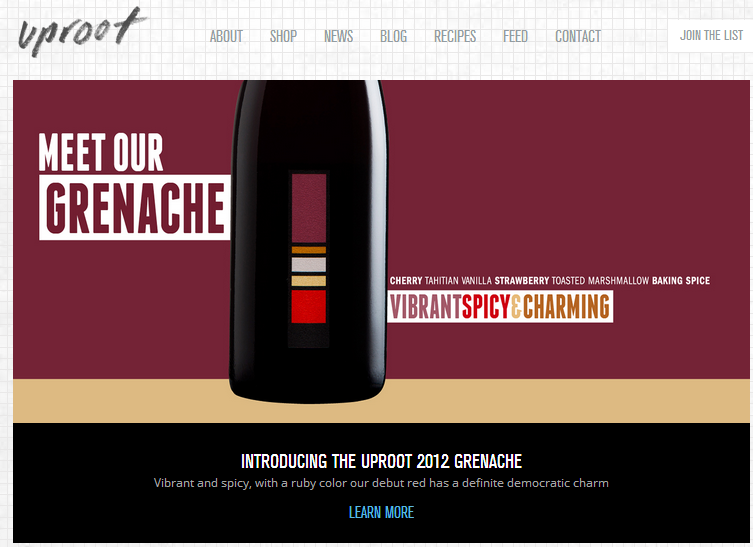How do you migrate from a successful SaaS venture capitalist and longtime technology industry native, into the founder of a successful wine brand? With a unique approach, some creativity, and the right partnerships, Uproot wines has done just that. Mixing the art of growth hacking, and knowledge from the startup world, Jay and Greg are carving out their niche in the wine market.
Unlike software though, where you can adopt a lean business model, while continually improving your product, wine requires the right stuff from the start. There are no test iterations of your Reserve Cabernet.
One of the more unique qualities of the wine industry is the huge range of individuals it attracts.
So how did a venture capitalist and a former New York office worker come together to form this brand? Greg Scheinfeld is a native of New York who left his desk job to work a harvest in 2006 and never looked back. After honing his skills at places like Joseph Phelps, Vineyard 29, and Cakebread Cellars, he moved on to start Uproot with Jay Levy. The two make for great combination, with Greg the meticulous winemaker, and Jay bringing his technical startup knowledge.
“We went all in, and knew what we wanted to do” says Jay, explaining their approach.
To stand out in the sea of wine brands, you need a strong differentiator, and that has been one of Uproot’s strengths. The wine’s labels feature unique color schemes that offer a visual match to the flavors contained within. It’s a simple, and overall subtle thing to put a wine’s flavors into a color palette, but for consumers it makes sense.
Their production is small, at just under 500 cases, and their model relies on the support of a directly connected base of consumers. Eager wine enthusiasts got first dibs on their releases, which include a Sauvignon Blanc, Grenache Blanc, and a new Grenache.
Establishing your customer base directly first, and then following up with limited distribution to restaurants and wine shops may seem backward to many wineries that follow the traditional three-tier model. But in building your customers one by one, and being selective about where your wine goes, you maintain much more control over the direction and growth.
I asked Jay about funding for their venture. He’s a well connected venture capitalist, with a great portfolio of companies behind him. If you had to guess, you’d think he poured a bunch into this new direction. You’d be wrong. While they have poured some into the production and necessary activities to build and sustain a wine brand, they fall more into the bootstrapped sort of approach, which can work when you take a ground-up approach with a product. By establishing a foundation of followers, fans, and customers, together with savvy content marketing and cross-lifestyle promotion online, they’ve gained a lot of exposure. The bootstrap style also helps build authenticity into their brand image.
“As a whole, we spent very little money on online marketing. We use storytelling and meeting directly with people to get the word out.”
Uproot’s primary market is milllenials, ages 28-45 who can afford and appreciate a $42 bottle of wine. Their website has a page dedicated to their values, another seemingly obvious, yet often ignored piece of many online businesses. One value in particular that I like is “customers are friends we haven’t met, yet” which is always a great way to go. They email people about once a month, and don’t get spammy with it.
They also make use of a good number of the small companies in the Zelkova portfolio, which helps them adapt to tech needs and develop a more agile approach. They use HelpScout to offer up friendly customer service, Ambassador for social referrals, and Crowdly which helps analyze their social media engagement.
This sort of approach is a dramatic contrast against the majority of other wineries out there, from the largest producers down to the smallest. In an industry rooted in agriculture, tradition, and prestige, technology has not been a strong adoption point.
“The industry is not leveraging the latest and greatest tech that it could be,” says Jay.
Specifically, he faults wineries for having antiquated consumer-facing websites. “You look at some of these websites, and it has the feel of 1996 tech. From a consumer-facing front end, it’s probably about 10 years behind.”
Another basic, yet effective way to establish that first touch point of communication with the customer happens via live chat on their website. I asked Jay about this, because it’s something that seems obvious to implement, and yet again, ignored by a good many wineries and small businesses alike. Jay says they have someone online “as much as possible” and they get about 5-10 conversations per day. Many want to simply say hello and have the chance to connect with someone behind the brand, while others want to ask a question about the wine. Having a live person can work great for a small business, plus it’s a easy way to create more connections with potential customers.
Uproot’s website and business is still in its infancy really, but has been a solid source for great wine-related content, such as the Guide to Napa, and simple but informative infographics. They engage, inform, and entertain their readers with content that has substance, although they did post the obligatory “bud break” post which every winery seems to do as part of their 4-post-per year schedule.
Going forward in 2014, they plan to expand their vision of a new kind of wine club called “The Block” and have just released their Grenache, which is a hot and heavy welcoming addition to the lineup of refreshing whites. Their wine club is free to join, and really just brings you on a level closer to the brand allowing the consumer more opportunity to join others and receive preferential treatment.





